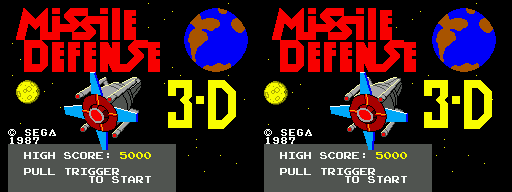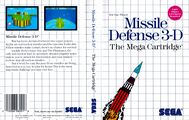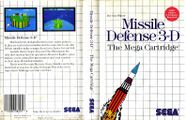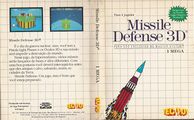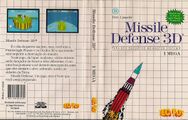Difference between revisions of "Missile Defense 3-D"
From Sega Retro
Scarred Sun (talk | contribs) m (Text replacement - "| segapro_source={{num|4|page=19}}" to "| segapro_source={{num|4|page=19|pdf=Segapro_UK_04.pdf|pdfpage=19}}") |
|||
| Line 11: | Line 11: | ||
| releases={{releases | | releases={{releases | ||
| sms_date_eu=1987-10 | | sms_date_eu=1987-10 | ||
| − | | sms_rrp_uk=24.95 | + | | sms_rrp_uk=24.95 {{fileref|ACE UK 16.pdf|page=166}} |
| sms_date_us=1987 | | sms_date_us=1987 | ||
| sms_date_br=19xx | | sms_date_br=19xx | ||
Revision as of 15:26, 5 July 2015
| Missile Defense 3-D | |||||
|---|---|---|---|---|---|
| System(s): Sega Master System | |||||
| Publisher: Sega | |||||
| Developer: Sega | |||||
| Peripherals supported: 3-D Glasses, Light Phaser | |||||
| Genre: Shooting | |||||
| Number of players: 1 | |||||
|
This short article is in need of work. You can help Sega Retro by adding to it.
Missile Defense 3-D, advertised as World War 3-D in early promotional material, is a shooting game developed and published by Sega for the Sega Master System. The game requires both the 3-D Glasses and Light Phaser to play.
The player assumes the role of an anti-nuclear satellite armed with a laser, with the mission of destroying all nuclear missiles launched by two superpowers at each other and the satellite. The missiles appear to fly towards the viewer (with the illusion of depth created by the 3-D Glasses), which must be shot with the Light Phaser before they hit their target.
Like SDI, Missile Defense was notorious for it's anti-nuclear war theming which hit close to home for many (as this game was made during the cold war). One example is that if one missile is allowed to make it's complete journey, the game will end and say "One missile hit east/west city. That's all it takes".
Credits
- Programmer: Mark Cerny
- Designer: Mark Cerny
Physical Scans
| Sega Retro Average | ||||||||||||||||||||||||||||||||||||||||||||||||||||||||||||||||
|---|---|---|---|---|---|---|---|---|---|---|---|---|---|---|---|---|---|---|---|---|---|---|---|---|---|---|---|---|---|---|---|---|---|---|---|---|---|---|---|---|---|---|---|---|---|---|---|---|---|---|---|---|---|---|---|---|---|---|---|---|---|---|---|---|
|
| 57 | |
|---|---|
| Based on 12 reviews | |
- ↑ File:Segapro_UK_04.pdf, page 19
- ↑ Complete Guide to Consoles, "Volume IV" (UK; 1990-11-xx), page 101
- ↑ The Complete Guide to Sega, "" (UK; 1991-05-xx), page 58
- ↑ Console XS, "June/July 1992" (UK; 1992-04-23), page 142
- ↑ Génération 4, "Janvier/Février 1988" (FR; 198x-xx-xx), page 47
- ↑ Mean Machines Sega, "October 1992" (UK; 1992-09-xx), page 135
- ↑ Power Play, "Ausgabe 2" (DE; 1987-12-28), page 92
- ↑ S: The Sega Magazine, "October 1990" (UK; 1990-09-06), page 13
- ↑ Sega Power, "October 1991" (UK; 1991-09-05), page 58
- ↑ Sega Pro, "February 1992" (UK; 1992-01-16), page 19
- ↑ Sega Pro, "April 1993" (UK; 1993-03-11), page 71
- ↑ Software Gids, "Mei/Juni 1990" (NL; 1990-05-xx), page 34
- ↑ Tilt, "Décembre 1987" (FR; 1987-1x-xx), page 106
